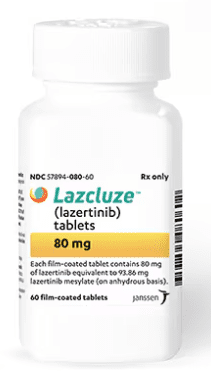Lazcluze Dosage
Generic name: LAZERTINIB 240mg
Dosage form: tablet, film coated
Medically reviewed by Drugs.com. Last updated on Aug 20, 2024.
Patient Selection
Select patients for the first-line treatment of NSCLC with LAZCLUZE, in combination with amivantamab, based on the presence of EGFR exon 19 deletions or exon 21 L858R substitution mutations in tumor or plasma specimens [see Clinical Studies (14)] . If these mutations are not detected in a plasma specimen, test tumor tissue. Information on FDA-approved tests is available at: http://www.fda.gov/CompanionDiagnostics.
Recommended Dosage and Administration
Recommended Dosage and Administration
The recommended dosage of LAZCLUZE is 240 mg orally once daily administered in combination with amivantamab with or without food. Swallow LAZCLUZE tablets whole. Do not crush, split, or chew. Continue treatment until disease progression or unacceptable toxicity.
Administer LAZCLUZE any time prior to amivantamab when given on the same day. Refer to the amivantamab prescribing information for recommended amivantamab dosing information.
Concomitant Medications
When initiating treatment with LAZCLUZE in combination with amivantamab, administer anticoagulant prophylaxis to prevent venous thromboembolic events (VTE) for the first four months of treatment [see Warnings and Precautions (5.1)]. If there are no signs or symptoms of VTE during the first four months of treatment, consider discontinuation of anticoagulant prophylaxis at the discretion of the healthcare provider.
When initiating treatment with LAZCLUZE in combination with amivantamab, administer alcohol-free (e.g., isopropanol-free, ethanol-free) emollient cream and encourage patients to limit sun exposure during and for 2 months after treatment, to wear protective clothing and use broad-spectrum UVA/UVB sunscreen to reduce the risk of dermatologic adverse reactions [see Warnings and Precautions (5.3)]. Consider prophylactic measures (e.g., use of oral antibiotics) to reduce the risk of dermatologic adverse reactions.
Dosage Modifications for Adverse Reactions
The recommended LAZCLUZE dose reductions for adverse reactions are presented in Table 1.
| Dose at which the adverse reaction occurred | 1 stDose Reduction | 2 ndDose Reduction | 3 rdDose Reduction |
|---|---|---|---|
| 240 mg once daily (one 240 mg tablet) |
160 mg once daily (two 80 mg tablets) |
80 mg once daily (one 80 mg tablet) |
Discontinue LAZCLUZE |
The recommended management and dosage modifications of LAZCLUZE for specific adverse reactions are presented in Table 2. Refer to the amivantamab prescribing information for information about dosage modifications for amivantamab.
| Adverse Reaction | Severity | Dosage Modification |
|---|---|---|
| Venous Thromboembolic Events (VTE) [see Warnings and Precautions (5.1)] |
Grade 2 or 3 |
|
| Grade 4 or recurrent Grade 2 or 3 despite therapeutic level anticoagulation |
|
|
| Interstitial Lung Disease (ILD)/Pneumonitis [see Warnings and Precautions (5.2)] |
Any Grade |
|
| Dermatologic Adverse Reactions (including dermatitis acneiform, pruritus, dry skin) [see Warnings and Precautions (5.3)] | Grade 1 |
|
| Grade 2 |
|
|
| Grade 3 |
|
|
| Grade 4 (including severe bullous, blistering or exfoliating skin conditions) |
|
|
| Other Adverse Reactions [see Adverse Reactions (6.1)] | Grade 3–4 |
|
More about Lazcluze (lazertinib)
Patient resources
Professional resources
Related treatment guides
Further information
Always consult your healthcare provider to ensure the information displayed on this page applies to your personal circumstances.


